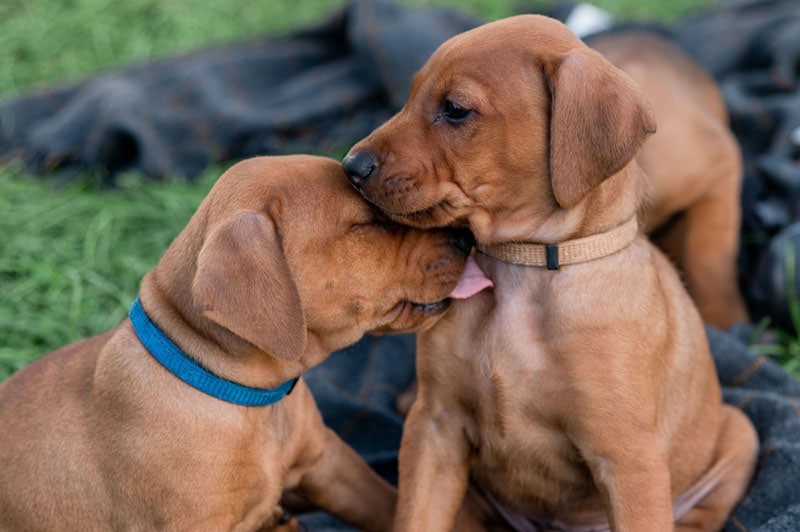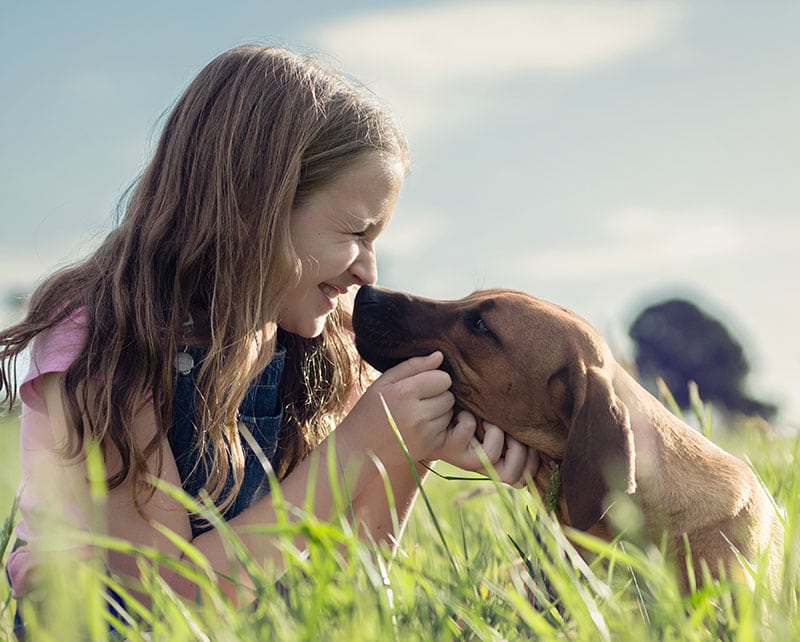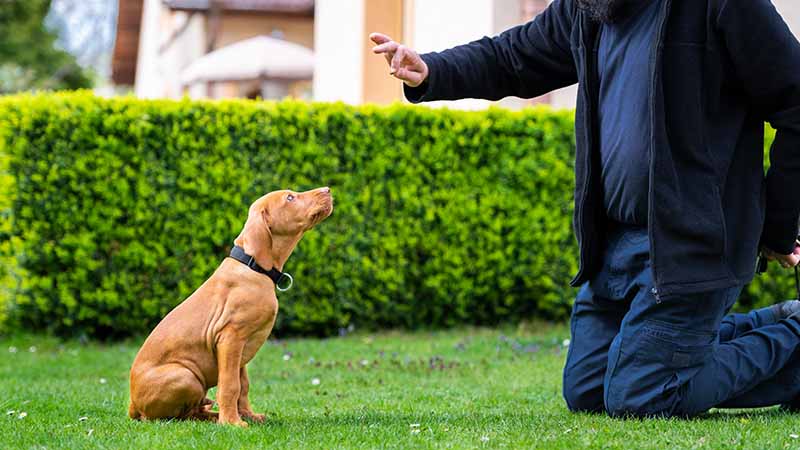Click to Skip Ahead
The Vizsla and Rhodesian Ridgeback breeds are short-haired dogs that are gorgeous, loyal, and intelligent. They were bred for hunting and endurance, and they make great companions and running partners for active owners.
Although the dogs have quite a few similarities, they also have several differences. If you’ve been thinking of adopting one of these dogs but can’t decide which is the best breed for you, it’s best to study each breed’s characteristics. In the guide below, we’ll discuss the similarities and differences between the two breeds so you can decide which dog to give a forever home.
Visual Differences

At a Glance
- Average height (adult): 24 to 27 inches
- Average weight (adult): 70 to 85 pounds
- Lifespan: 10 to 12 years
- Exercise: 1 to 2 hours a day
- Grooming needs: Low
- Family-friendly: Yes
- Other pet-friendly: Yes
- Trainability: Intelligent, loyal, strong-willed
- Average height (adult): 21 to 24 inches
- Average weight (adult): 45 to 65 pounds
- Lifespan: 10 to 14 years
- Exercise: 2+ hours a day
- Grooming needs: Low
- Family-friendly: Yes
- Other pet-friendly: Yes
- Trainability: Energetic, intelligent, easy to train
Rhodesian Ridgeback Overview

The Rhodesian Ridgeback is a breed that was initially bred in South Africa. However, they originated in what used to be known as Rhodesia but is now called Zimbabwe. Also called the African Lion Hound, these dogs were bred to withstand the heat and were also capable, loyal, and fierce protectors.
The dogs’ days of hunting lions are long behind them, and you’ll mostly find them as companion animals in today’s world. Although they used to be called “lion hounds,” Ridgebacks only tracked lions for hunters and did not attack them. We’ll discuss more about the Rhodesian Ridgeback’s personality, exercise needs, and health issues in the sections below.
Personality
You may know that Rhodesian Ridgebacks are known to be intelligent, affectionate dogs. However, did you know they’re also known for being strong-willed and stubborn? They are very independent, but that doesn’t stop them from being great family dogs. Their independence doesn’t prevent them from being loyal and protective of their family.
They are good guard dogs, and though they are protective, it’s very rare for them to attack a human. While they can be wary around strangers, they eventually warm up to them and can become one of their best friends. However, Ridgebacks require early socialization since they tend to chase cats and other small animals if given the chance.

Exercise
The Rhodesian Ridgeback is an active breed that will need 1 to 2 hours of daily exercise. However, they are nowhere near as active as the Vizsla, so if you’re searching for a pet that is content to sit on the couch with you after exercising, the Ridgeback is an ideal choice. However, the dog will bark constantly if it becomes bored and doesn’t behave well when left alone for long periods.
Training
Although the Rhodesian Ridgeback is intelligent, it’s also willful and stubborn. The dog can be challenging to train because of their stubborn nature. That’s why people who have never had experience training a large dog before should not adopt a Rhodesian Ridgeback Dog as their first pet.
The Ridgeback has a high prey drive, so if you want it to be around smaller pets, you will have to socialize and train the dog early. If you can be consistent and patient but firm with your dog, training can go well; it will just be difficult.

Health Issues
Like most purebred dogs, the Rhodesian Ridgeback has a few health problems they’re vulnerable to. Although your Ridgeback may never experience the conditions below, it’s wise to become familiar with them and talk to your vet if you have any concerns.
- Hypothyroidism
- Deafness
- Hip dysplasia
- Dermoid sinus
- Cataracts
The best way to ensure that your dog doesn’t suffer from these conditions is to take the dog for regular checkups, so the signs can be spotted early and treated.
Suitable For:
We’ve mentioned that the Rhodesian Ridgeback is a large dog and that they are willful and difficult to train. Therefore, they should be adopted by an owner who can handle the training to keep them in line. While they are loving, loyal, intelligent dogs, they have a strong prey drive and must be socialized and trained when they are still puppies. They also need a huge yard to roam, so if you live in an apartment, you might need to consider another breed for a pet.
Vizsla Overview

The Vizsla Dog breed was originally bred in Hungary and was used during the First World War to deliver messages to the troops. They were also used to point and retrieve games for hunters. They’re popular working animals even today but almost became extinct after the war. However, a group of determined dog lovers brought them back, and there are plenty in the world today for you to give a forever home. In the sections below, we’ll discuss the personality, exercise requirements, and health issues to watch out for with the Vizsla.
Personality / Character
Vizslas are loyal, affectionate, active dogs that love nothing more than a good run. They work hard but are just as happy after exercise, sitting on the couch watching TV with their pet parents. Vizslas are considered a Velcro breed and suffer from separation anxiety if they are away from their owners for hours.
You must ensure you have the time to spend with your Vizsla before giving one a forever home. However, the Vizsla makes a wonderful companion if you’re home often and can provide enough exercise for the energetic pup.

Exercise
Since the Vizsla was bred for running and tracking, they will need plenty of off-leash exercise. Vizslas are one of the fastest dogs in the world, so they need plenty of space to run. You should expect to exercise your furry friend for at least 2 hours a day or more. A quick stroll around the neighborhood isn’t going to work for this breed, but they make exceptional partners for jogging and hiking.
Training
Since the Vizsla was bred to be close to humans, training the dog isn’t as hard as you might think. They have a natural desire to please their pet parents and are intelligent, and they pick up on orders and commands quickly and follow through with no problem. They are easy to train but do not respond well to being yelled at, punished, or talked to harshly.
You must be patient and loving with this dog if you want results. Positive reinforcement works well with Vizslas, and they seem to enjoy the praise almost as much as the treats.

Health Issues
When properly cared for, Vizslas are relatively healthy dogs, but we’ll list some of the most common health conditions they experience below.
- Hypothyroidism
- Von Willebrand’s Disease
- Hip dysplasia
- Epilepsy
- Progressive retina atrophy
If you purchase your Vizsla through a breeder, they should provide documents that list their vaccinations and health tests. Most reputable breeders screen their dogs to ensure they’re not vulnerable to developing diseases like hip dysplasia.
Suitable For:
The Vizsla makes an excellent pet for the right family. They are large and fast, so you need to be careful when they’re playing with smaller children; they could easily become injured if they run over a tiny kid in their excitement while playing. If you have a large farm or a huge yard, the Vizsla will be right at home. However, since they need to be able to run several miles a day, apartment living is not the best choice for the breed.
Which Breed Is Right for You?
Both breeds are similar in ways, such as their appearance, size, affection, and loyalty. However, there are a couple of differences you should look out for when deciding what the best pet is for you and your family.
Vizslas are clingy and prefer to be at their pet parent’s side whenever possible. The Rhodesian Ridgeback is more independent and won’t mind being alone if you’re gone for a few hours. The Vizsla is a good choice for beginning pet owners since they are easy to train and eager to please.
The Rhodesian Ridgeback, however, is stubborn and quite difficult to train, so you need to be experienced to give this breed a forever home. Whichever breed you choose, you will get a loyal, loving dog that will shower you with love and affection for many years.
Featured Image Credit: Top – Nina Quka, Pexels | Bottom – Vizslafotozas, Pixabay













